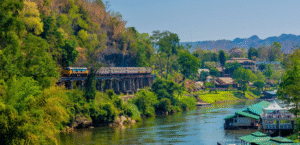China : Domestic tourism receives a boost , 637 million visits during 8-day holiday

Beijing : Affluent Chinese tourists chose to travel within the country, rather than abroad, during the eight-day National Day holiday, with customized travel packages and personalized services being the most preferred options, experts said.
“Many big spenders altered their overseas travel plans as they were apprehensive about the increase in the number of COVID-19 cases in some countries and regions. Limited access to international flights and cruises was another major deterrent to overseas travel,” said Wei Pengju, director of the Institute of Cultural Economics at the Central University of Finance and Economics in Beijing.
“A large number of travelers chose domestic destinations. Luxury travelers opted to spend more on customized travel plans and personalized services for comfortable experiences, an indication that an industry rebound is just around the corner,” he said.
According to data from search engine Baidu, a week before the holiday, a time when most people finalize their travel plans, the number of searches for “domestic travel” and “self-driving road trips” surged by 2,374 percent and 18 percent respectively on a yearly basis. On the other hand, searches for “overseas travel”, and “travel with agencies” dropped by 59 percent and 23 percent respectively on a yearly basis.
Demand from affluent travelers has also attracted the attention of travel agencies and related businesses, who have started rolling out more high-end plans and services, Liu Yukun reports in China Daily .
According to data from travel booking platform Ctrip, its offline store in Chongqing made a booking for an eight-day luxury travel plan in Northwest China worth 15,000 yuan ($2,209) per person for four people, according to Jiemian.com, a news website. The price was much higher than the average 3,000 yuan to 5,000 yuan per person for the same place or similar destinations.
Another offline store in Hangzhou made a travel plan to Sanya, Hainan province, for 37 travelers, involving a spending of 350,000 yuan. A travel plan to Sanya made by an offline Traveling Bestone store in Shanxi for six adults and two children cost travelers nearly 70,000 yuan, according to Jiemian.
“Aside from the rising number of high-end travel plans and services in the market, other changes that the COVID-19 epidemic has brought to the industry include more road trips by private cars and recreation vehicles to avoid public contagion and increasing need for good quality accommodation services due to hygiene concerns,” said Wei.
Data from Baidu showed that a week before the holidays, searches for “restaurants” increased by 30 percent on a yearly basis, much higher than “homestay services”.
Strong tourism recovery seen during 8-day holiday
Similarly , Cheng Si reports in China Daily – A nationwide travel boom during the National Day and Mid-Autumn Festival holiday sent a clear signal that China is emerging from the impact of the COVID-19 pandemic.
Figures from the Ministry of Culture and Tourism on Thursday showed that over 637 million visits were made to attractions on the Chinese mainland during the eight-day extended break, compared with 782 million visits during the seven-day holiday in 2019.
On Sept 18, the ministry raised the cap on the number of daily visitors at tourist spots nationwide from 50 percent of operating capacity to 75 percent during the holiday.
Domestic tourism market revenue exceeded 466 billion yuan ($68.6 billion) during the eight days, compared with 649.7 billion yuan during the holiday last year. The holiday was extended by one day this year to incorporate the Mid-Autumn Festival, which fell on Oct 1, also National Day.
Qunar, an online travel service provider, said the Tibet autonomous region and Qinghai and Hainan provinces saw the best recoveries, with reservations to the three destinations on its platform up by more than 30 percent year-on-year.
Among popular attractions, those in northwestern and southwestern provinces that usually take longer to travel to, such as Xi’an in Shaanxi province and Dali and Lijiang in Yunnan province, were preferred by travelers.
Lvmama, another online travel agency, said in a report that the 10 most popular destinations on the Chinese mainland over the holiday were: Hangzhou, Zhejiang province; Sanya, Hainan province; Chengdu and the Aba Tibetan and Qiang autonomous prefecture, Sichuan province; Guilin, Guangxi Zhuang autonomous region; Dali and Lijiang; Beijing; Lanzhou, Gansu province; Xiamen, Fujian province; and Xi’an.
Self-driving tours proved popular with travelers looking for greater privacy amid coronavirus concerns and wanting more relaxed travel schedules.
A report by Trip.com, another online travel agency, said reservations for cars and self-driving tours hit a record high over the break, with the average number of cars rented on its platform each day up by 50 percent.It said travelers spent an average of about 2,000 yuan on car rental.
Northwestern provinces were the big winners in attracting self-driving travelers, with reservations for self-driving holidays up 140 percent year-on-year in Xining, Qinghai province.
Trip.com said the booming self-driving market showed that the tourism sector was shaking off the impact of the pandemic and was on the path to a strong recovery. Source : China Daily
Image : People visit the West Lake in Hangzhou, capital of East China’s Zhejiang province, October 1, 2020. [Photo/Xinhua]
October 10 , 2020














